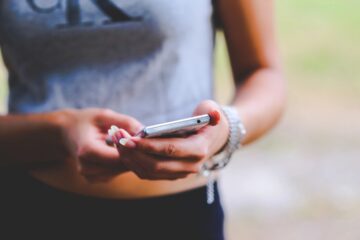In today’s world, iPhones let us do just about anything—from working and gaming to browsing the internet and staying in touch with loved ones. But while smartphones come with plenty of benefits, they can also feel overwhelming. It’s easy to get hooked, especially when you’re constantly scrolling through social media or playing games.
Thankfully, there’s a simple way to help you stay more present in the real world: you can scale back your iPhone’s features. Yes, really.
By “dumbing down” your iPhone, you can reduce distractions and spend less time on social media or interacting with people you don’t truly know. It’s a useful shift if you’re looking to reclaim your time and attention.
How to Simplify Your iPhone
There are a few different ways to make your iPhone less distracting, depending on how much control you want over your apps and usage. The easiest method uses a built-in feature called Assistive Access, which makes the transition quick and straightforward.
Assistive Access is an iPhone accessibility feature designed to support individuals with cognitive disabilities. When enabled, it limits the Home Screen to only the apps you select, creating a simpler, more focused user experience.

However, anyone can use this to block distracting apps and iPhone features while keeping the most important apps and notifications available. Here’s how you can set it up:
- Open the Settings app.
- Scroll down and go to Accessibility.
- Scroll down to the bottom and tap on Assistive Access.
- Tap on Set Up Assistive Access.
- Tap on Continue.
- Confirm that the Apple Account (Apple ID) associated with the iPhone is the one you want to use. If not, tap on Change Apple Account at the bottom of your screen.
- Choose the Appearance you want. You can choose a Row or a Grid layout. Then, tap on Continue.
- Tap the plus icon next to the apps you want to add to Assistive Access. Then, tap on Continue.
- Tap on Continue one more time.
- Confirm that you’ve set up your Face ID and Passcode before continuing.
- Enter an Assistive Access password. If you have someone you can trust, you can tell them to enter a passcode you don’t know about, so you can’t be tempted to exit Assistive Access for yourself.
- Tap on Continue one last time.
- Tap Enter Assistive Access and enter the passcode.
That’s it — you’re now using Assistive Access! You’ll notice that only the apps you chose during setup are available, helping you stay focused and reduce screen time. You also won’t get notifications from any apps outside of your selection, making it easier to disconnect.
If you ever want to exit Assistive Access, just press the side button three times and tap Exit Assistive Access. You’ll need to enter the special four-digit Assistive Access passcode, which is separate from your regular iPhone passcode.
Other Ways to Make Your iPhone Dumber
Assistive Access offers a fast and simple way to streamline your iPhone by restricting access to apps you’d rather avoid. However, there’s a trade-off: it significantly limits your iPhone’s functionality. That might be exactly what you’re going for—but if you’d prefer to keep the standard iOS experience while just cutting back on distractions, manually blocking certain apps might be a better fit. Here’s how to get started:
- Open the Settings app.
- Scroll down and select Screen Time.
- If this is the first time you’ve used Screen Time for yourself, you’ll need to select App & Website Activity and then Turn on App & Website Activity at the welcome screen to continue.
- Select App Limits
- Tap on Add Limit.
- Choose the app or category of apps you want to limit and then tap on Next at the top right.
- Choose a specific amount of time you want to allow yourself to use the apps you selected. If you don’t want any time, you can set it to one minute. Tap Add at the top right corner when you’re done.

You can also use the Downtime feature, which limits your access to only the apps you’ve approved during specific hours. You can either enable Downtime manually or set a schedule for it to turn on automatically at certain times.
To choose which apps remain accessible during Downtime, go to Always Allowed in the Screen Time settings and select the apps you want to keep available.
For even more control, scroll to the bottom of the Screen Time menu and tap Lock Screen Time Settings. This allows you to set a Screen Time passcode, which prevents you from turning off Downtime or changing app limits without entering the code. For added accountability, consider asking a friend or family member to set the passcode for you.
Finally, it’s a good idea to review your notification settings. Head to Settings > Notifications and turn off alerts from apps you don’t need constant updates from. Messaging apps like WhatsApp or Discord and social platforms like TikTok and Instagram are common sources of distraction—disabling their notifications can help you stay focused throughout the day.
Why It’s A Good Idea
At first glance, the idea of making a smartphone “dumb” might seem counterintuitive. After all, you bought it to take advantage of all the powerful apps and features, right? While that’s true, too much of anything—even technology—can be overwhelming, especially when it comes to platforms designed for instant gratification, like social media, games, and entertainment apps.
But turning your iPhone into a simpler device isn’t just about cutting out the negatives—it can actually bring a range of unexpected benefits:
1. Boost Your Productivity
By reducing constant notifications and limiting access to distracting apps, you can create space to focus on what truly matters. Whether you’re trying to work, study, or just complete your daily tasks, a “dumb” iPhone removes temptations and helps you stay on track.
2. Avoid Digital Burnout
According to McLean Hospital, digital burnout is the result of “anxiety, exhaustion, and apathy caused by spending too much time on digital devices.” Sound familiar? You’re not alone. More and more people are experiencing this form of burnout. Scaling back your screen time by simplifying your phone can ease that mental load and help you feel more balanced.
3. Strengthen Your Relationships
Modern communication often revolves around texts and video calls. While these tools are convenient, they can sometimes replace meaningful in-person interactions. Limiting your phone use may encourage more face-to-face conversations and spontaneous meetups. Plus, without constant pings and pop-ups, you’ll be more present in the moment with the people around you.
4. Carve Out Time for Yourself
Even when you’re alone, your phone can crowd out personal time. Maybe you intended to read, exercise, or just relax—but an app pulled you in before you even noticed. That’s not entirely your fault—many apps are designed to capture your attention. Reducing access to them, even occasionally, helps reclaim your time and focus on hobbies or self-care.
5. Save Time, Money, and Energy
When your phone is less engaging, you’ll naturally check it less often. That means less screen time, longer battery life, fewer charges, and less wear on your device over time. It’s a small shift that can have a big impact.
Simplifying your iPhone with features like Assistive Access or app restrictions isn’t about giving something up—it’s about gaining back your time, focus, and peace of mind.
Simplifying your phone can be both helpful and freeing. By eliminating distracting and addictive apps, you could improve your real-life focus and experience a variety of benefits.
We’re not suggesting you remove every app or game that could pull you in. However, if you’re feeling overwhelmed by the constant barrage of notifications, turning your iPhone into a “dumb” phone is a quick and effective way to regain control.
As we’ve mentioned, making your iPhone simpler is easy to do, but it may take some time to adjust. You’ll likely need to practice resisting the urge to grab your phone constantly and instead focus on other aspects of your life. But, as the saying goes, practice makes perfect.
Source: iDropNews




